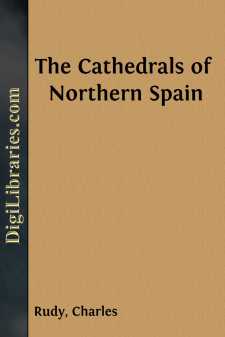Categories
- Antiques & Collectibles 13
- Architecture 36
- Art 48
- Bibles 22
- Biography & Autobiography 813
- Body, Mind & Spirit 142
- Business & Economics 28
- Children's Books 17
- Children's Fiction 14
- Computers 4
- Cooking 94
- Crafts & Hobbies 4
- Drama 346
- Education 46
- Family & Relationships 57
- Fiction 11829
- Games 19
- Gardening 17
- Health & Fitness 34
- History 1377
- House & Home 1
- Humor 147
- Juvenile Fiction 1873
- Juvenile Nonfiction 202
- Language Arts & Disciplines 88
- Law 16
- Literary Collections 686
- Literary Criticism 179
- Mathematics 13
- Medical 41
- Music 40
- Nature 179
- Non-Classifiable 1768
- Performing Arts 7
- Periodicals 1453
- Philosophy 64
- Photography 2
- Poetry 896
- Political Science 203
- Psychology 42
- Reference 154
- Religion 513
- Science 126
- Self-Help 84
- Social Science 81
- Sports & Recreation 34
- Study Aids 3
- Technology & Engineering 59
- Transportation 23
- Travel 463
- True Crime 29
The Cathedrals of Northern Spain
by: Charles Rudy
Description:
Excerpt
GENERAL REMARKS
History and architecture go hand in hand; the former is not complete if it does not mention the latter, and the latter is incomprehensible if the former is entirely ignored.
The following chapters are therefore historical and architectural; they are based on evolutionary principles and seek to demonstrate the motives of certain artistic phenomena.
Many of the ideas superficially mentioned in the following essays will be severely discussed, for they are original; others are based on two excellent modern historical works, namely, "The History of the Spanish{14} People," by Major Martin Hume, and "Historia de España," by Señor Rafael Altamira. These two works can be regarded as the dernier mot concerning the evolution of Spanish history.
Unluckily, however, the author has been unable to consult any work on architecture which might have given him a concise idea of the story of its gradual evolution and development, and of the different art-waves which flowed across the peninsula during the stormy period of the middle ages, which, properly speaking, begins with the Arab invasion of the eighth century and ends with the fall of Granada, in the fifteenth.
Several works on Spanish architecture have been written (the reader will find them mentioned elsewhere), but none treats the matter from an evolutionary standpoint. On the contrary, most of them are limited to the study of a period, of a style or of a locality; hence they cannot claim to be a dernier mot. Such a work has still to be written.
Be it understood, nevertheless, that the author does not pretend—Dios me libre!—to have supplied the lack in the following pages. In a couple of thousand words it would be utterly impossible to do so. No;{15} a complete, evolutionary study of Spanish architecture would imply years of labour, of travel, and of study. For so much on the peninsula is hybrid and exotic, and yet again, so much is peculiar to Spain alone. Thus it is often most difficult to determine which art phenomena are natural—that is, which are the logical results of a well-defined art movement—and which are artificial or the casual product of elements utterly foreign to Spanish soil.
Willingly the author leaves to other and wiser heads the solving of the above riddle. He hopes, nevertheless, that they (those who care to undertake the mentioned task) will find some remarks or some observations in the following chapters to help them discover the real truth concerning the Spaniard's love, or his insensibility for architectural monuments, as well as his share in the erection of cathedrals, palaces, and castles.
Spanish architecture—better still, architecture in Spain—is peculiarly strange and foreign to us Northerners. We admire many edifices in Iberia, but are unable to say wherefore; we are overawed at the magnificence displayed in the interior of cathedral churches and at a loss to explain the reason.{16}
As regards the former, it can be attributed to the Oriental spirit still throbbing in the country; not in vain did the Moor inhabit Iberia for nearly eight hundred years...!


